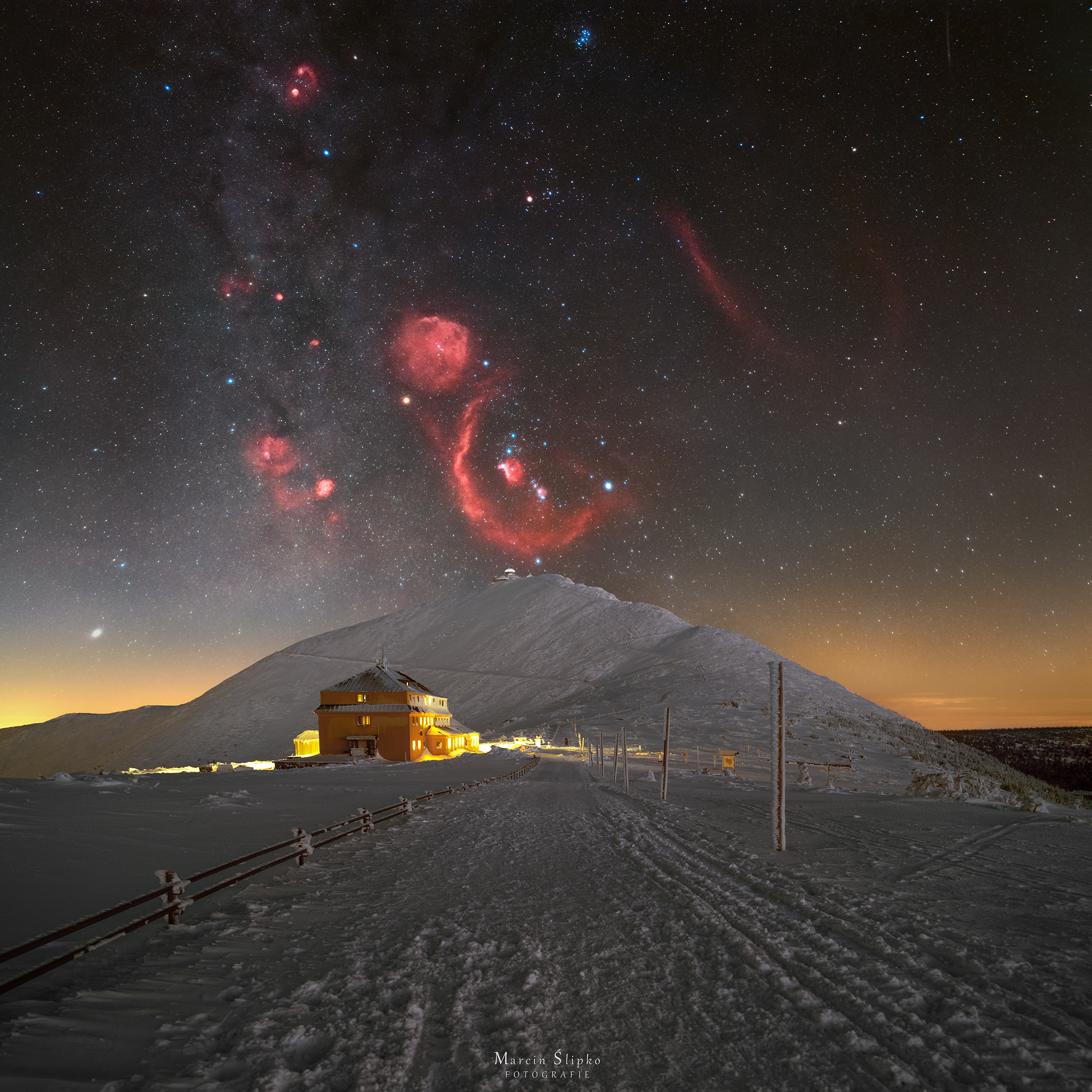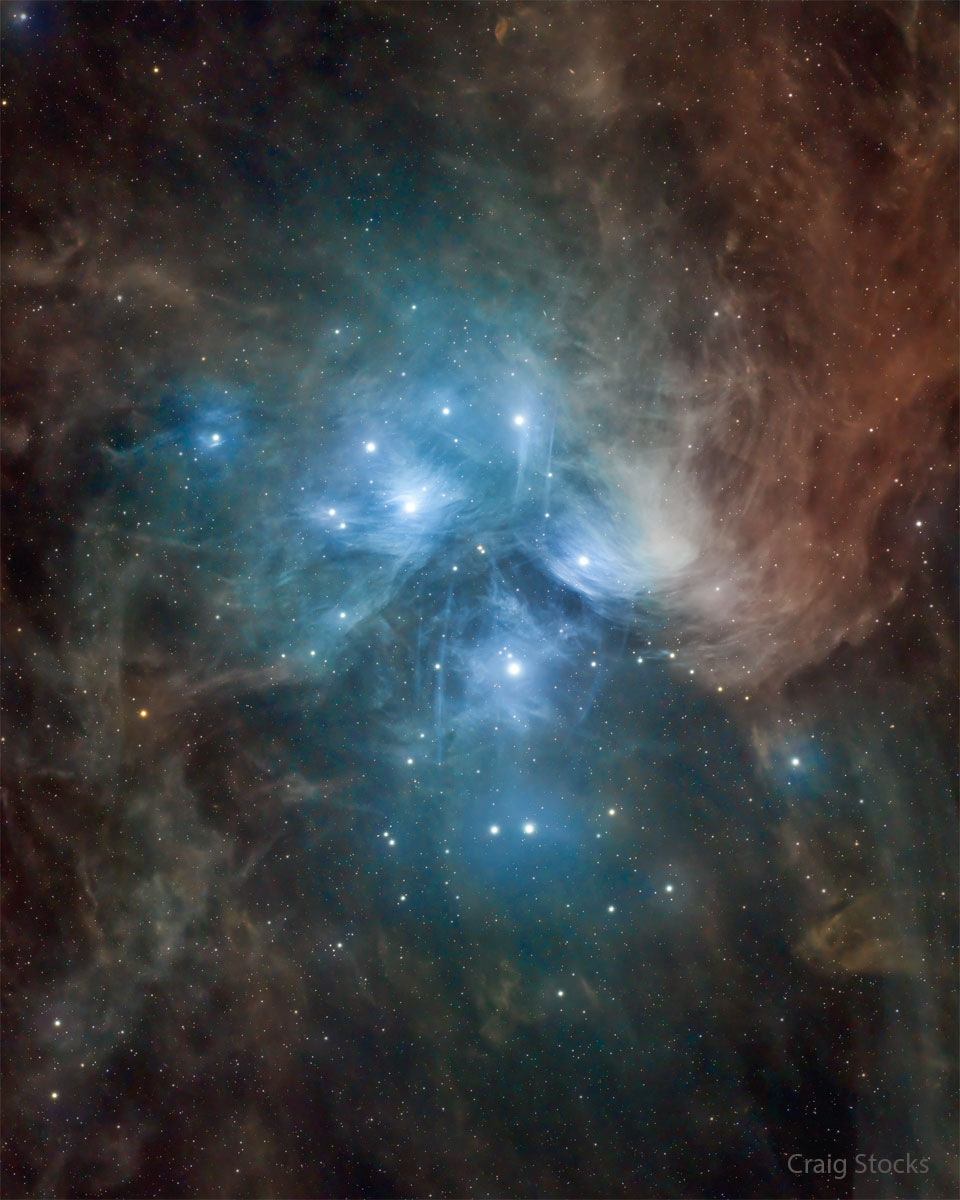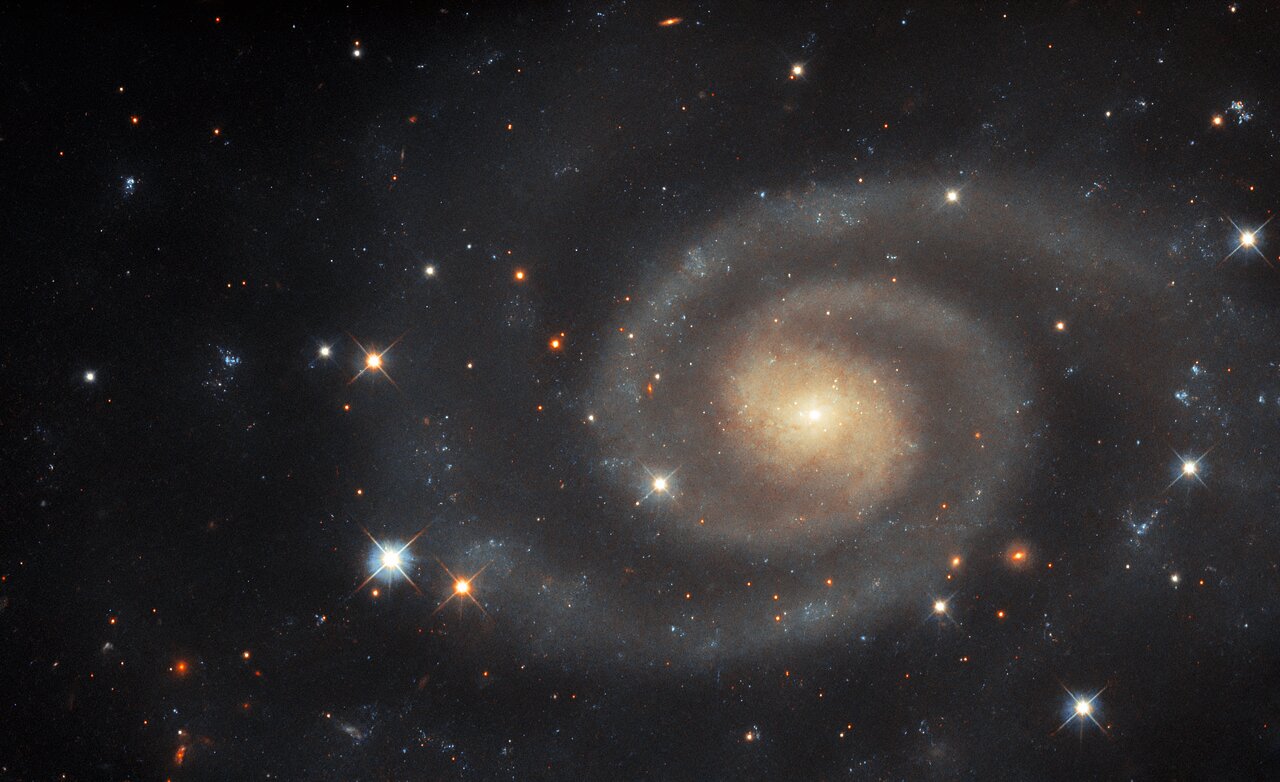The famous constellation is visible to the southeast just after sunset. From most Earthly locations, Orion’s familiar star pattern, highlighted by the three-stars-in-a-row belt stars, rises sideways. An entire section of the night sky that includes Orion was photographed rising above Śnieżka, a mountain on the border between Poland and the Czech Republic. The long duration exposure sequence brings up many faint features including the Orion and Flame Nebulas, both encompassed by the curving Barnard’s Loop. The featured wide-angle camera composite also captured night sky icons including the blue Pleiades star cluster at the image top and the red Rosette Nebula to the left of Orion. Famous stars in the frame include Sirius, Betelgeuse, Rigel and Aldebaran. Orion will appear successively higher in the sky at sunset during the coming months.

see full post...
Franz Peter Schubert ; 31 January 1797 – 19 November 1828) was an Austrian composer of the late Classical and early Romantic eras. Despite his short life, Schubert left behind a vast oeuvre, including more than 600 secular vocal works (mainly lieder), seven complete symphonies, sacred music, operas, incidental music, and a large body of piano and chamber music. His major works include the art songs Erlkönig, Gretchen am Spinnrade, Ave Maria; the Trout Quintet, the unfinished Symphony No. 8 in B minor, the “Great” Symphony No. 9 in C major, the String Quartet No. 14 “Death and the Maiden”, a String Quintet, the two sets of Impromptus for solo piano, the three last piano sonatas, the Fantasia in F minor for piano four hands, the opera Fierrabras, the incidental music to the play Rosamunde, and the song cycles Die schöne Müllerin, Winterreise and Schwanengesang.
Born in the Himmelpfortgrund suburb of Vienna, Schubert showed uncommon gifts for music from an early age. His father gave him his first violin lessons and his elder brother gave him piano lessons, but Schubert soon exceeded their abilities. In 1808, at the age of eleven, he became a pupil at the Stadtkonvikt school, where he became acquainted with the orchestral music of Joseph Haydn, Wolfgang Amadeus Mozart, and Ludwig van Beethoven. He left the Stadtkonvikt at the end of 1813 and returned home to live with his father, where he began studying to become a schoolteacher. Despite this, he continued his studies in composition with Antonio Salieri and still composed prolifically. In 1821, Schubert was admitted to the Gesellschaft der Musikfreunde as a performing member, which helped establish his name among the Viennese citizenry. He gave a concert of his works to critical acclaim in March 1828, the only time he did so in his career. He died eight months later at the age of 31, the cause officially attributed to typhoid fever, but believed by some historians to be syphilis.
Appreciation of Schubert’s music while he was alive was limited to a relatively small circle of admirers in Vienna, but interest in his work increased greatly in the decades following his death. Felix Mendelssohn, Robert Schumann, Franz Liszt, Johannes Brahms and other 19th-century composers discovered and championed his works. Today, Schubert is ranked among the greatest composers in the history of Western classical music and his work continues to be admired and widely performed.
see full post...
Charles Douglas Musselwhite (born January 31, 1944) is an American blues harmonica player and bandleader, one who came to prominence, along with Mike Bloomfield, Paul Butterfield, and Elvin Bishop, as a pivotal figure in helping to revive the Chicago Blues movement of the 1960s. He has often been identified as a “white bluesman”. Musselwhite was reportedly the inspiration for Elwood Blues; the character played by Dan Aykroyd in the 1980 film, The Blues Brothers.
Musselwhite, whose father and paternal grandfather were also named Charlie Musselwhite (making him Charlie Musselwhite III), was born in Kosciusko, Mississippi to white parents. Originally claiming to be of partly Choctaw descent, in a 2005 interview he said his mother had told him he was of distant Cherokee descent. His family considered it natural to play music. His father played guitar and harmonica, his mother played piano, and a relative was a one-man band.
see full post...Philip Glass (born January 31, 1937 Baltimore, MD) is an American composer and pianist. He is widely regarded as one of the most influential composers of the late 20th century. Glass’s work has been associated with minimalism, being built up from repetitive phrases and shifting layers. Glass describes himself as a composer of “music with repetitive structures”, which he has helped to evolve stylistically.
Glass founded the Philip Glass Ensemble, which is still in existence, but Glass no longer performs with the ensemble. He has written fifteen operas, numerous chamber operas and musical theatre works, fourteen symphonies, twelve concertos, nine string quartets, various other chamber music pieces, and many film scores. Three of his film scores have been nominated for Academy Awards.
see full post...Roosevelt Sykes (January 31, 1906 – July 17, 1983) was an American blues musician, also known as “the Honeydripper“. Sykes was born the son of a musician in Elmar, Arkansas. “Just a little old sawmill town”, Sykes said of his birthplace. The Sykes family was living in St. Louis by 1909. Sykes often visited his grandfather’s farm near West Helena. He began playing the church organ around the age of ten. “Every summer I would go down to Helena to visit my grandfather on his farm,” he told biographer Valerie Wilmer. “He was a preacher and he had an organ I used to practice on, trying to learn how to play. I always liked the sound of the blues, liked to hear people singing, and since I was singing first, I was trying to play like I sang.” Sykes was baptized at 13 years old, his lifelong beliefs never conflicting with playing the blues.
see full post...The well-known Pleiades star cluster is slowly destroying part of a passing cloud of gas and dust. The Pleiades is the brightest open cluster of stars on Earth’s sky and can be seen from almost any northerly location with the unaided eye. Over the past 100,000 years, a field of gas and dust is moving by chance right through the Pleiades star cluster and is causing a strong reaction between the stars and dust. The passing cloud might be part of the Radcliffe wave, a newly discovered structure of gas and dust connecting several regions of star formation in the nearby part of our Milky Way galaxy. Pressure from the stars’ light significantly repels the dust in the surrounding blue reflection nebula, with smaller dust particles being repelled more strongly. A short-term result is that parts of the dust cloud have become filamentary and stratified. The featured deep image incorporates nearly 9 hours of exposure and was captured from Utah Desert Remote Observatory in Utah, USA, last year.

Philip David Charles Collins LVO (born 30 January 1951) is an English singer, drummer, songwriter, record producer and actor. He was the drummer and later became the lead singer of the rock band Genesis and had a successful solo career, achieving three UK number one singles and seven US number one singles as a solo artist. In total, his work with Genesis, other artists, and solo resulted in more US top-40 singles than any other artist throughout the 1980s. His most successful singles from the period include “In the Air Tonight“, “Against All Odds (Take a Look at Me Now)“, “One More Night“, “Sussudio“, “Another Day in Paradise” and “I Wish It Would Rain Down“.
Born and raised in west London, Collins began playing drums at age five. During the same period he attended drama school which secured him various roles as a child actor. His first major role was the Artful Dodger in the West End production of the musical Oliver!. As an accomplished professional actor by his early teens, he pivoted to pursue a music career, becoming the drummer for Genesis in 1970, at age 19. He took over the role of lead singer in 1975 following the departure of Peter Gabriel. During the second half of the 1970s, in-between Genesis albums and tours, Collins was also the drummer of jazz rock band Brand X. Collins began a successful solo career in the 1980s, initially inspired by his marital breakdown and love of soul music, releasing the albums Face Value (1981), Hello, I Must Be Going (1982), No Jacket Required(1985) and …But Seriously (1989). Collins became, in the words of AllMusic, “one of the most successful pop and adult contemporary singers of the ’80s and beyond”. He also became known for a distinctive gated reverb drum sound on many of his recordings. He played drums on the 1984 charity single “Do They Know It’s Christmas?, and in July 1985, he was the only artist to perform at both Live Aid concerts. He also resumed his acting career, appearing in Miami Vice and subsequently starring in the film Buster(1988).
see full post...Martyn Jerel Buchwald (January 30, 1942 – September 27, 2018), known as Marty Balin , was an American singer, songwriter, and musician best known as the founder/leader and one of the lead singers and songwriters of Jefferson Airplane and Jefferson Starship.
Balin was born Martyn Jerel Buchwald in Cincinnati, Ohio, the son of Catherine Eugenia “Jean” (née Talbot) and Joseph Buchwald. His paternal grandparents emigrated from Eastern Europe. His father was Jewish and his mother was Episcopalian Buchwald attended Washington High School in San Francisco, California. As a child, Balin was diagnosed with autism.
see full post...Edward Brian “Tubby” Hayes (30 January 1935– 8 June 1973) was an English jazz multi-instrumentalist, best known for his virtuosic musicianship on tenor saxophone and for performing in jazz groups with fellow sax player Ronnie Scott and trumpeter Jimmy Deuchar. He is widely considered to be one of the finest jazz saxophonists to have emerged from Britain. Hayes died in June 1973, during a second heart operation at the Hammersmith Hospital, at the age of 38.
see full post...Ahmed Abdul-Malik (born Jonathan Tim, Jr.; January 30, 1927 – October 2, 1993) was an American jazz double bassist and oud player. Abdul-Malik is remembered for integrating Middle Eastern and North African music styles in his jazz music. He was a bass player for Art Blakey, Earl Hines, Randy Weston, and Thelonious Monk, among others.
see full post...
David Roy Eldridge (January 30, 1911 – February 26, 1989), nicknamed “Little Jazz“, was an American jazz trumpeter. His sophisticated use of harmony, including the use of tritone substitutions, his virtuosic solos exhibiting a departure from the dominant style of jazz trumpet innovator Louis Armstrong, and his strong impact on Dizzy Gillespie mark him as one of the most influential musicians of the swing era and a precursor of bebop.
Eldridge was born on the North Side of Pittsburgh, Pennsylvania, on January 30, 1911, to parents Alexander, a wagon teamster, and Blanche, a gifted pianist with a talent for reproducing music by ear, a trait that Eldridge claimed to have inherited from her. Eldridge began playing the piano at the age of five; he claimed to have been able to play coherent blues licks at even this young age.
see full post...This image of the spiral galaxy UGC 11105 is not as bright and vivid as some other Hubble Pictures of the Week. This softly luminous galaxy — lying in the constellation Hercules, about 110 million light-years from Earth — seems outshone by the sparkling foreground stars that surround it. The type II supernova which took place in this galaxy in 2019, while no longer visible in this image, definitely outshone the galaxy at the time! To be more precise, UGC 11105 has an apparent magnitude of around 13.6 in the optical light regime (this image was created using data that covers the heart of the optical regime, in addition to ultraviolet data). Astronomers have different ways of quantifying how bright celestial objects are, and apparent magnitude is one of them.
Firstly, the ‘apparent’ part of this quantity refers to the fact that apparent magnitude only describes how bright objects appear to be from Earth, which is not the same thing as measuring how bright they actually are. For example, in reality the variable star Betelgeuse is about 21 000 times brighter than our Sun, but because the Sun is much, much closer to Earth, Betelgeuse appears to be vastly less bright than it. The ‘magnitude’ part is a little harder to describe, because the magnitude scale does not have a unit associated with it, unlike, for example, mass, which we measure in kilograms, or length, which we measure in metres. Magnitude values only have meaning relative to other magnitude values. Furthermore, the scale is not linear, but is a type of mathematical scale known as ‘reverse logarithmic’, which also means that lower-magnitude objects are brighter than higher-magnitude objects.
As an example, UGC 11105 has an apparent magnitude of around 13.6 in the optical, whereas the Sun has an apparent magnitude of about -26.8. Accounting for the reverse logarithmic scale, this means that the Sun appears to be about 14 thousand trillion times brighter than UGC 11105 from our perspective here on Earth, even though UGC 11105 is an entire galaxy! The faintest stars that humans can see with the naked eye come in at about sixth magnitude, with most galaxies being much dimmer than this. Hubble, however, has been known to detect objects with apparent magnitudes up to the extraordinary value of 31, so UGC 11105 does not really present much of a challenge.

James Lee Jamerson (January 29, 1936 – August 2, 1983) was an American bass player. He was the uncredited bassist on most of the Motown Records hits in the 1960s and early 1970s (Motown did not list session musician credits on their releases until 1971), and is now regarded as one of the most influential bass players in modern music history. He was inducted into the Rock and Roll Hall of Fame in 2000. As a session musician he played on twenty-three Billboard Hot 100 number-one hits, as well as fifty-six R&Bnumber-one hits.
In its special issue “The 100 Greatest Bass Players” in 2017, Bass Player magazine ranked Jamerson number one and called him the most important and influential bass guitarist. In 2020, Rolling Stonemagazine ranked Jamerson number one in its list of the 50 greatest bassists of all time.
A native of Edisto Island, South Carolina, he was born to James Jamerson Sr. and Elizabeth Bacon. He was raised in part by his grandmother who played piano, and his aunt who sang in church choir. As a child he was a competent piano player and performed in public. He briefly played the trombone. As a teenager he was a reserved person, and passionate about music. He listened to gospel, blues and jazz music on the radio.
see full post...Edwin Thomas “Ed” Shaughnessy (January 29, 1929 – May 24, 2013) was a swing music and jazz drummer long associated with Doc Severinsen and a member of The Tonight Show Band on The Tonight Show Starring Johnny Carson.
Shaughnessy was born in Jersey City, New Jersey and grew up in the New York City area, working in the 1940s with George Shearing, Jack Teagarden, and Charlie Ventura. In the 1950s he worked in the Charlie Ventura, Benny Goodman and Tommy Dorsey bands. In the 1960s he played for Count Basie prior to joining The Tonight Show Band. He was the drummer on Bashin’: The Unpredictable Jimmy Smith in 1962 which featured big band arrangements by Oliver Nelson, including the pop hit “Walk on the Wild Side” which peaked at #21 on the Billboard chart. Shaughnessy recorded extensively throughout his career and was known for his drum competitions with Buddy Rich.
see full post...